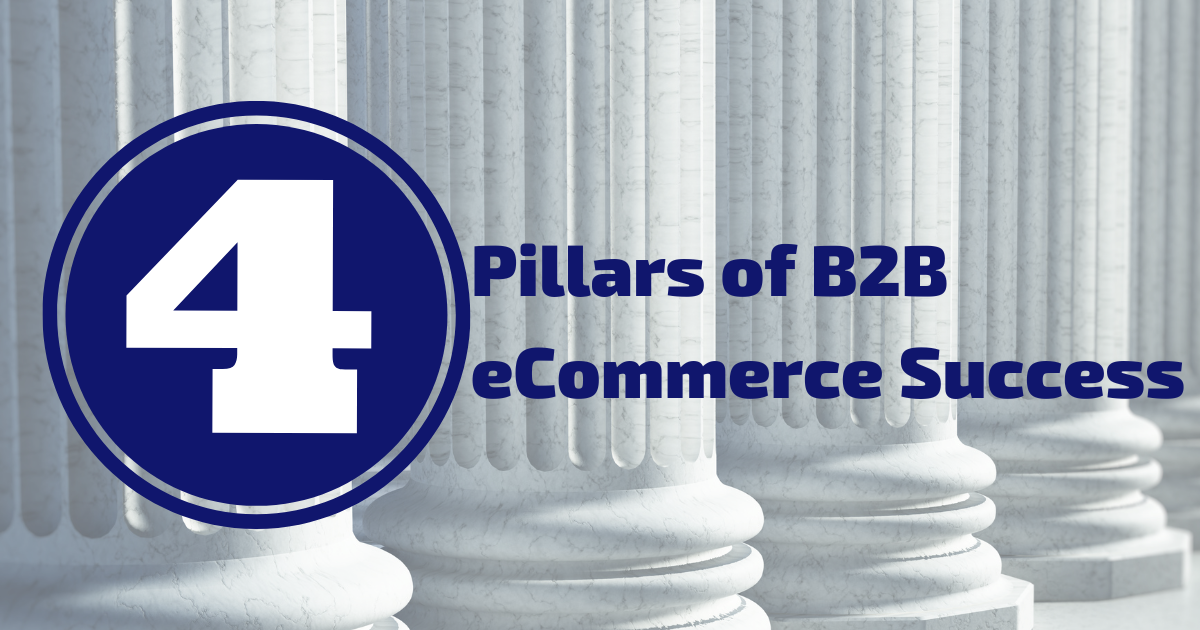The 4 Pillars of B2B E-Commerce Success
Composable IT architectures and API future-proof integration allow companies to assemble a best-in-breed tech stack that conforms to their unique operational processes. Each software component is developed, tested, integrated, and deployed independently with significantly less customer and operational disruption than large-scale conversions.
The 4 pillars of a successful B2B e-commerce strategy are:
-
Unified, structured product data & media assets
1.
-
Efficient, repeatable customer order processes
2.
-
Fast product discovery & intuitive site navigation
3.
-
Interactive digital sales consultation technology
4.
Companies in the process of upgrading to a composable future-proof system architecture grew 1.8 times faster than their competitors, according to Forrester Market Insights.
1. Unified, Structured Product Data & Media Assets
The #1 barrier to successful e-commerce conversions is fragmented, unstructured product information that isn’t optimized for efficient publication across all channels and marketplaces in any language.
Digital marketplaces are expanding rapidly making product data syndication more complex due to the multiple formats required for internal and external data feeds. Furthermore, marketing and sales spend considerable time gathering and verifying product information they need to launch campaigns, spin up storefronts, or create customized catalogs in real time.
Although next-generation ERP platforms are designed for omni-channel sales, most don’t have the functionality to optimize complex and/or high-volume product catalogs typically carried by B2B manufacturers, wholesalers, and distributors.
“Our internal PIM was not geared towards marketing information. It was a manufacturing PIM with tiny descriptions in ERP which work for production and assembly, but not for our website (search & display).
When I looked at the (product) attributes available, the (navigation) menu hierarchy; they just weren’t web ready.” ~ Ted Wichman – CIO at Superior Communications
PIM middleware acts as a control tower to consolidate and structure product and customer data to make the omni-channel buyer journey more efficient through:
- Dynamic merchandising offers
- Channel-specific storefronts
- Targeted product catalogs & product recommendations
- Up-to-the-minute stock availability and pricing
- Dynamic trade show presentations & product demonstrations
- Personalized newsletters, email promotions, & social media communications
Modern PIMs have a Master Data Management (MDM) component to securely centralize all company information for improved data governance.
More: https://csscommerce.com/case_studies/trade-service/
“Trade Service imports product information for millions of SKUs from thousands of manufacturers and consolidates them into digital databases for marketplace syndication.”
2. Efficient, Repeatable Customer Order Processes
Well-designed customer portals offer a suite of B2B buyer-managed tools that can be optimized to their unique business processes and user preferences such as:
- Set up & manage multi-tiered, multi-domain corporate structures
- Create multiple buyer roles, spend limits, & purchasing permissions
- Track order status, manage quotes, and submit RFQs
- Manage credit, pay invoices, and request product returns
- Automate repeat orders & subscription billings
- Upload CSV/XLXS files for large orders
- Add internal product numbers for better findability
- Store relevant product content for easy access
“The new My CNHI Store holds customer-specific pricing, terms, product information, and diagrams. The Sales Department is closing more deals and faster with real-time product information and availability at their fingertips. Consolidation expanded brand awareness across product lines.” Bane-Welker Equipment
3. Fast Product Discovery & Intuitive Navigation
B2B buyers tend to perform independent research to first qualify suppliers before contacting sales reps or product managers for deeper insights. You have less than 3 seconds to capture their attention and deliver relevant search results and timely product information feeds or you may lose them to a competitor.
AI/ML search & navigation platforms can analyze buyer behavioral signals to automate the curation of relevant product & merchandising content across all channels, languages, and touchpoints. Fast, AI-driven search results, category drill-down, semantic keyword analysis, and dynamic ML content curation can:
- Lengthen customer engagement time
- Reduce bounce & abandonment rates
- Increase conversions & average order values.
Don’t overload buyers with information. According to research from Harvard Business Review, too much information/ too fast drives an 18% decrease in purchasing ease. The trick is to improve buyer efficiency and strike the right balance between digital automation and the need for sales agent intervention.
More: https://csscommerce.com/case_studies/marks-plumbing/
“By creating a ranked Search system with SOLR Search, the buyer’s search delivers not just the part they requested but we also display, as an alternative, the part or product that had the highest margin for Mark’s, most often their own OEM brand. It was usually less expensive to the buyer, but offered a higher margin to Mark’s.”
4. Leverage Digital Sales Consultation Technology
B2B sales is often a complex process with multiple customer touchpoints and technical consultations that result in fragmented customer communications which often lead to misunderstandings. Integrated interactive digital sales portals provide the ability to:
- Visually curate merchandising offers & product demonstrations from a single platform
- Create individual, hybrid, and interactive video events and product demonstrations
- Integrate 3D visuals, integrated pricing, customer analytics, technical documentation, product data sheets, and targeted product recommendations to up- & cross-sell
- Shorten long sales cycles and troubleshoot in real time
- Present product & promotional offers directly to the customer portal
- Create Shoppable marketing collateral including direct links to the shopping cart
ROI & TCO Factors
The path to e-commerce success for mid-market B2B distributors and manufacturers is a long one where total-cost-of-ownership (TCO) and return-on-investment (ROI) calculations are highly complex. ROI is generated incrementally with each new deployment, and ownership costs are spread over several years.
Digitalized operations can have a massive impact on:
Operational Efficiency
- Integrated product data lifecycle management with automated workflows & notifications
- The automation of repetitive tasks, content curation, & marketplace dataset transfers
- Automatic language translation & cultural preferences for ease-of-access to global markets
- No-code point-and-click API integration for new deployments
- Interactive digital sales to reduce travel expenses
Revenue Growth
- Refocus liberated staff resources to revenue-generating activities
- Dynamic curation of timely product information & creative merchandising offers
- User-friendly drag-and-drop interface to spin up targeted storefronts & catalogs
- Centralized self-service customer portals & media storage
- End-to-end value chain systems integration & analytics
Look for platform solutions that offer future-fit scalability, API-first closed-loop integration, and extensible open-source code that can be configured to your exact B2B processes rather than undertake costly customizations. Ask for a free assessment from one of our eCommerce consultants here.



